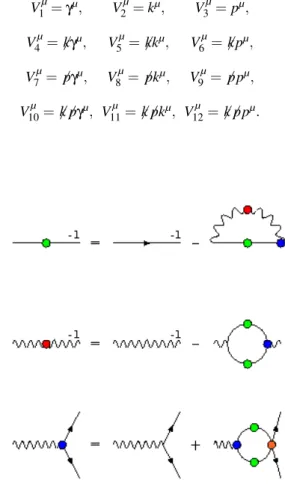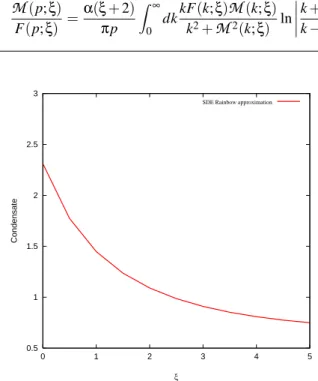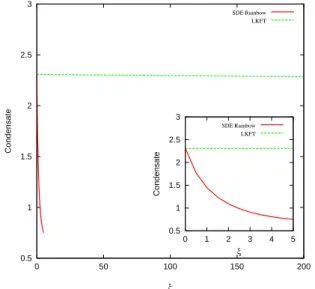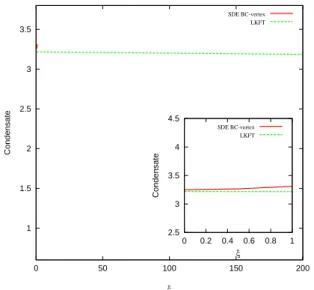Gauge Covariance and the Chiral Condenate in QED3
A. Bashir1,2 and A. Raya1
1Instituto de F´ısica y Matem´aticas, Universidad Michoacana de San Nicol ´as de Hidalgo,
Apartado Postal 2-82, Morelia, Michoac´an 58040, M´exico and 2IPPP, Durham University, Durham DH1 3LE, United Kingdom.
(Received on 13 September, 2006)
The ambiguities associated with the lack of gauge invariance in the non-perturbative truncations of Schwinger-Dyson equations (SDEs) are a challenging problem which has not yet been resolved in a deci-sive fashion. Pursuing this aim, we study dynamical chiral symmetry breaking in quantum electrodynamics in three space-time dimensions (QED3). We investigate the gauge dependence of the chiral condensate both in the quenched and the unquenched versions of the theory and emphasize the importance of taking into ac-count the gauge covariance properties of the fermion propagator as dictated by its Landau-Khalatnikov-Fradkin transformation (LKFT). We present numerical solutions of the SDE of the fermion propagator which respect Ward-Green-Takahashi identities (WGTI) and LKFT simultaneously. As a striking consequence, we obtain a practically gauge independent chiral condensate.
Keywords: Schwinger-Dyson equations; Dynamical Chiral Symmetry Breaking; Landau-Khalatnikov-Fradkin transforma-tions
I. INTRODUCTION
Gauge theories of fundamental interactions have been highly successful in collating experimental results in the per-turbative regime. However, not all interesting phenomena can be understood in this approximation scheme. Confinement of quarks and gluons and the origin of hadronic masses are two examples. It is well known that on the distance scale of the order of hadron size, quarks behave as though their mass were 300 MeV, much larger than their vanishingly small cur-rent mass. In the context of covariant gauges, this effect may be attributed to an interplay of the behaviour of gluon and ghost propagators in the infrared, [1]. These studies through Schwinger-Dyson equations (SDEs) have only been carried out in the Landau gauge. It is well known that if care is not taken in their truncation, solutions can be gauge dependent.
Let alone the complicated battle ground of non-Abelian the-ories, the ambiguities associated with the lack of gauge invari-ance in the non-perturbative truncations of SDEs in Abelian theories such as QED are also a challenging problem. Among others isuues, it has ultraviolet divergences. Consequently, a neater testing ground for the validity of various truncations is provided by QED3, which is super-renormalizable. However, a recent study, [2], has revealed that the problem of gauge in-variance persists even in this seemingly simple scenario.
In addition to being a toy model for SDEs studies, QED3 is an attractive theory in its own right. In condensed matter physics, for example, it is used in the context of high-Tc su-perconductors [3], studies which have received a boost from new experiments [4], and in the recently explored unconven-tional Quantum Hall Effect in Graphene [5]. Addiunconven-tionally, in the realm of dynamical generation of fundamental fermion masses, numerical findings on the lattice, results obtained by employing SDEs, [6], and alternative methods, [7], have yet to arrive at a final consensus, and continue to provide a popular battle ground.
The problem of gauge invariance in QED3 can be traced back to not employing (or doing so incorrectly) the gauge identities such as the Ward-Green-Takahashi
identi-ties (WGTI) [8], the Nielsen identiidenti-ties [9] and the Landau-Khalatnikov-Fradkin transformations (LKFT) [10]. Here we address this issue in the light of the LKFT, following and ex-tending the analysis of Ref. [11]. These transformations de-scribe the specific manner in which Green functions transform under a variation of gauge. These are non-perturbative in na-ture, and thus are expected to be very helpful in studies of phe-nomena realized only non perturbatively, such as dynamical chiral symmetry breaking. Initial steps were taken in [12] to apply LKFT directly to the dynamically generated mass func-tion, whereas the complete numerical implementation of LK-FTs on solutions to SDEs in various truncation schemes was performed in [11] to study the gauge dependence of the chiral condensate in QED3. In this work we extend the analysis to a wider range of values of the gauge parameter.
ap-proach to achieve the same objective. We propose to start from the solution for the fermion propagator in the Landau gauge and simply perform an LKFT to find the result in any other gauge. It is important to note that LKFT does not fix the fermion propagator in the starting gauge, e.g., the Landau gauge. If one starts from a flawed starting solution, one does not expect to arrive at a trustable answer in an arbitrary gauge through the use of corresponding LKFT. Therefore, it is im-portant to establish the validity of a vertexansatzin the start-ing gauge. Once it has been achieved and owstart-ing to the fact that LKFT preserve WGTI, the advantage of this proposal is to conserve both the WGTI and LKFT as we move from one value of the gauge parameter to another. In this contribution, we present results coming from the computation of the chi-ral condensate as a function of gauge both for the quenched and the unquenched cases and find the results to be practically gauge independent.
We have organized this work as follows : In section II, we introduce the general features of the phenomenon of dynam-ical mass generation in QED3 within the context of SDEs in the Rainbow approximation. In section III, we present the LKFT for the fermion propagator and the strategy for its im-plementation in SDEs studies. In Sect. IV we review further truncation schemes in the light of the LKFT. Finally, we dis-cuss our results and draw our conclusions in section V.
II. SCHWINGER-DYSON EQUATIONS AND DYNAMICAL
CHIRAL SYMMETRY BREAKING
We know that perturbation theory in QED does not gener-ate fermion masses dynamically. Non-perturbative methods have to be employed and SDEs are the natural tool for calcu-lation in continuum. The first three equations of the infinite tower of SDEs in QED are depicted in Fig. 1. These corre-spond to the fermion propagator, the photon propagator and the fermion-boson vertex, respectively. The fermion propaga-tor is coupled to the photon propagapropaga-tor and the fermion-boson vertex, which, through their own SDE, are coupled to the rest of the infinite tower containing higher point Green functions.
The SDE for the fermion propagator in QED3 is : S−1(p;ξ) = S−01(p)
+ e2
Z d3k
(2π)3Γν(k,p;ξ)S(k;ξ)γµ∆µν(q), (1) where q =k−p and e2 is the dimensionful coupling of QED3. In this expression∆µν(q)is the photon propagator and
Γµ(k,p;ξ)the full fermion-boson vertex. The most general form of the (Ecuclidean) fermion propagator is
S(p;ξ) = F(p;ξ)
i6p−
M
(p;ξ) (2) whereF is referred to as the fermion wavefunction renormal-ization andM
is the mass function. The photon propagator in its most general form can be written as∆µν(q) =
G
(q2) q2
µ
δµν−
qµqν
q2
¶
+ξqµqν q4
≡ ∆T µν(q) +ξ
qµqν
q4 , (3)
where
G
is the photon wavefunction renormalization, which is gauge invariant, andξ is the usual covariant gauge para-meter. Finally, the fermion-boson vertex can be written as Γµ(k,p;ξ) =∑12i=1vi(k,p;ξ)V µ i ,where
V1µ=γµ, Vµ
2 =kµ, V µ 3 =pµ, V4µ=6kγµ, Vµ
5 =6kkµ, V µ 6 =6k pµ, V7µ=6pγµ, Vµ
8 =6pkµ, V µ 9 =6ppµ, V10µ =6k6pγµ, Vµ
11=6k6pkµ, V µ
12=6k6ppµ.
(4)
FIG. 1: SDEs for the fermion propagator, photon propagator and fermion-boson vertex.
1
F(p;ξ)=1− αξ 4π
Z ∞
0 dk k
2F(k;ξ) k2+
M
2(k;ξ)· 1−k
2+p2 2k p ln
¯ ¯ ¯ ¯
k+p k−p
¯ ¯ ¯ ¯ ¸
,
M
(p;ξ) F(p;ξ) =α(ξ+2) πp
Z ∞
0
dkkF(k;ξ)
M
(k;ξ) k2+M
2(k;ξ) ln¯ ¯ ¯ ¯
k+p k−p
¯ ¯ ¯ ¯
,(5)
whereα=e2/4π as usual. In the Landau gaugeF(p; 0) = 1 and thus we have to solve but one equation for the mass function :
M
(p;ξ) =2α πpZ ∞
0
dk k
M
(k;ξ) k2+M
2(k;ξ)ln¯ ¯ ¯ ¯
k+p k−p
¯ ¯ ¯ ¯
. (6)
In Fig. 2, we show the profile of the mass function, Refs. [15, 22].
M
(p; 0)is roughly a constant for low momentum and fall as 1/p2as p→∞, [22].0 0.02 0.04 0.06 0.08 0.1 0.12 0.14
0.001 0.01 0.1 1 10 100 1000
M(p)
p
SDE Rainbow approximation ξ=0
FIG. 2: Mass function from SDE in the Landau gauge in the Rainbow approximation.
From this solution can can compute the chiral condensate
hψψ¯ i=−TrS(x=0,ξ). When this exerecise is performed in different gauges, i.e., solving simultaneously the eqs. in (5), one faces the undesirable fact of the condensate being gauge dependent, as shown in Fig. 3. One can expect the source of such gauge dependence the fact that the bare vertex violates the WGTI
iqµΓµ(k,p;ξ) =S−1(k;ξ)−S−1(p;ξ). (7) Nevertheless, this identity is satisfied in the Landau gauge (asF(p; 0) =1) upto a correction connected with the differ-ence
M
(k; 0)−M
(p; 0)of the mass function. This correction might be expected to be small becauseM
(k; 0)∼M
(p; 0)for small values of momenta and falls sharply for large momenta. In other gauges,F(p;ξ)6=1 and the above argument does not apply. Thus, if one insists on sticking to the Rainbow approx-imation, only the results in the Laundau gauge can be reliable. However, one could use the LKFT to generate solutions in other gauges [23]. Below we present the corresponding analy-sis for the chiral condensate.0.5 1 1.5 2 2.5 3
0 1 2 3 4 5
Condensate
ξ
SDE Rainbow approximation
FIG. 3: Gauge dependence of the chiral condensate (in units of 10−3e4) from SDE in the Rainbow approximation.
III. LANDAU-KHALATNIKOV-FRADKIN
TRSNFORMATIONS AND THE FERMION PROPAGATOR
We start by writing the Euclidean coordinate space fermion propagator in its most general form :
S(x;ξ) ≡ 6xX(x;ξ) +Y(x;ξ). (8)
Expressions in eqs. (2) and (8) are related through Fourier transformations :
S(p;ξ) =
Z
d3xeip·xS(x;ξ), S(x;ξ) =
Z d3p
(2π)3 e
−ip·xS(p
;ξ). (9)
Assuming we know the fermion propagator in Landau gauge in momentum space,S(p; 0), we have the following expres-sions in coordinate space
X(x; 0) = −i x2
Z d3k
(2π)3
F(k; 0) k2+
M
2(k; 0)e−ik·xk·x,
Y(x; 0) = −
Z d3k
(2π)3
F(k; 0)
M
(k; 0) k2+M
2(k; 0) e−ik·x.
(10)
The LKFT relating the coordinate space fermion propagator in the Landau gauge to the one in an arbitrary covariant gauge reads
where
∆d(x) = −iξe2
Z ddp
(2π)d e−ip·x
p4 , (12)
d being the number of space-time dimensions. For d=3, ∆3(0)−∆3(x) =−iαξ/2. Therefore,
S(x;ξ) = S(x; 0)e−ax, (13) witha=αξ/2. After applying LKFT to the expressions in eq. (10) and Fourier transforming the results back to momen-tum space, we get
F(p;ξ) p2+
M
2(p;ξ) =a πp2
Z ∞
0
dk k2 F(k; 0) k2+
M
2(k; 0)×· 1
λ−+
1
λ++
1 2k pln
¯ ¯ ¯ ¯ λ− λ+ ¯ ¯ ¯ ¯ ¸ ,
F(p;ξ)
M
(p;ξ) p2+M
2(p;ξ) =a πp
Z ∞
0
dk kF(k; 0)
M
(k; 0) k2+M
2(k; 0) ×· 1
λ−−
1 λ+
¸
, (14)
whereλ±=a2+(k±p)2. Thus knowledge ofS(p; 0)is the in-put required to obtain the same in an arbitrary covariant gauge. When we insert the solution for the mass function in the Landau gauge, eq. (6), into eqs. (14) and compute the chiral
condensate, we find the striking flat curve shown in Fig. 4 (green-dashed), as compared with the SDE solution (red-solid). Furthermore, with this procedure, we can go as far as we wish in varying the gauge parameter (here uptoξ=200), a hard nut to crack in SDE studies [15, 22].
A linear fit of the gauge dependence of the condensate re-veals thathψψ¯ i ≃2.30783−0.000113777ξ, which suggest that the condensate, scaled by a factor of 10−3, would vanish for a value ofξv>20000, provided a good numerical accu-racy is achieved.
IV. FURTHER TRUNCATIONS
In order to test the procedure outlined above, we review two further examples of truncation schemes of SDEs.
A. Ball-Chiu Vertex
The Ball-Chiu vertex (BC-vertex), eq. (3.2) in [13] was constructed to fulfill the WGTI non-perturbatively. In the quenched truncation, the corresponding SDEs become more involved. Inserting the BC-vertex in the SDE, the unknownF and
M
are found through the system of equations1
F(p;ξ) = 1+ α πp2
Z ∞
0 dk k
2F(k;ξ) k2+
M
2(k;ξ)(
a(k,p)
"
−ξ
µ 1−k
2+p2 2k p ln
¯ ¯ ¯ ¯
k+p k−p
¯ ¯ ¯ ¯
¶#
+b(k,p)
"
2(k2+p2)
µ 1−k
2+p2 2k p ln
¯ ¯ ¯ ¯
k+p k−p
¯ ¯ ¯ ¯ ¶ −ξ µ
k2+p2−(k
2−p2)2 2k p ln
¯ ¯ ¯ ¯
k+p k−p
¯ ¯ ¯ ¯
¶#
−c(k,p)
"
2 µ
1−k
2+p2 2k p ln
¯ ¯ ¯ ¯
k+p k−p
¯ ¯ ¯ ¯ ¶ −ξ µ 1−k
2−p2 2k p ln
¯ ¯ ¯ ¯
k+p k−p
¯ ¯ ¯ ¯ ¶#) ,
M
(p;ξ) F(p;ξ) =α π
Z ∞
0 dk k
2F(k;ξ) k2+
M
2(k;ξ)(
a(k,p)
M
(k;ξ)"
(2+ξ) 1 k pln
¯ ¯ ¯ ¯
k+p k−p
¯ ¯ ¯ ¯ #
+b(k,p)
M
(k;ξ)"
2(k2+p2) k p ln
¯ ¯ ¯ ¯
k+p k−p
¯ ¯ ¯ ¯
+2(ξ−2)
#
+c(k,p)
"
(2+ξ)k2+ (2−ξ)p2
2k p ln
¯ ¯ ¯ ¯
k+p k−p
¯ ¯ ¯ ¯
+ (ξ−2)
#)
, (15)
where
a(k,p) = 1 2 "
1 F(k;ξ)+
1 F(p;ξ)
#
,
b(k,p) = 1 2
1 (k2−p2)
" 1 F(k;ξ)−
1 F(p;ξ)
#
,
c(k,p) = − 1
(k2−p2)
"
M
(k;ξ)F(k;ξ) −
M
(p;ξ) F(p;ξ)#
. (16)
0.5 1 1.5 2 2.5 3
0 50 100 150 200
Condensate
ξ
SDE Rainbow LKFT
0.5 1 1.5 2 2.5 3
0 1 2 3 4 5
Condensate
ξ SDE Rainbow
LKFT
FIG. 4: Gauge dependence of the chiral condensate (in units of 10−3e4) in the Rainbow approximation: LKFT (green-dashed) vs. SDE (red-solid).
BC-vertex in the Landau gauge to other gauges and compute the chiral condensate, we find that this quantity is virtually gauge independent, as can be seen from Fig. 5 (green-dashed
line), where a comparison against SDE results (red-solid line) is also shown. Again, a linear fit reveals that the gauge depen-dence of the condensate ishψψ¯ i ≃3.21685−0.000157548ξ, leading to a vanishing condensate forξv>20000, a behavior very similar to that of the Rainbow approximation.
B. Unquenched QED3
In this case the SDE for the fermion propagator, eq. (1) has to be simultaneously solved with the corresponding SDE for the photon propagator withNf flavors of degenerate fermions :
∆−1
µν(q) = ∆0µν
−1
(q)
−Nfe2
Z d3k
(2π)3Tr[γµS(k;ξ)Γν(k,q;ξ)S(q;ξ)]. (17) This exercise has been carried out in [2] employing a hybrid choice of the three point interaction. For the fermion propaga-tor, the well-tested Curtis-Pennington vertex (CP-vertex) [14] was used, whereas the BC-vertex was implemented in the SDE of the photon propagator to avoid unwanted divergences. UnknownsF,
M
andG
are found through the equations :1
F(p;ξ) = 1+ α 2π2p2
Z d3k
q2
F(k;ξ) k2+
M
2(k;ξ)"
G
(q)(
a(k,p) 2q2
¡
−q4+ (k2−p2)2¢
−
· 1 F(k;ξ)−
1 F(p;ξ)
¸Ω(k,p) 2 (k
2+p2−q2)
−
·
b(k,p)(k2+p2)−c(k,p)
M
(k;ξ) 2q2¸ ¡
−q4+2q2(k2+p2)−(k2−p2)2¢ )
+ξ
(
a(k,p) 2q2 (q
2(k2+p2)−(k2−p2)2)−b(k,p)(k2−p2)2 2q2 (k
2+p2−q2) +c(k,p)
2q2
M
(k;ξ)¡
(k2−p2)2−q2(k2−p2)¢ )#
,
M
(p;ξ) F(p;ξ) =α 2π2
Z d3k
q2
F(k;ξ) k2+
M
2(k;ξ)"
G
(q)(
2a(k,p)
M
(k;ξ)−M
(k;ξ)· 1 F(k;ξ)−
1 F(p;ξ)
¸
Ω(k,p)
+
·
2b(k,p)
M
(k;ξ) +c(k,p) 2q2¸ ¡
−q4+2q2(k2+p2)−(k2−p2)2¢ )
+ξ
(
a(k,p)
M
(k;ξ) +b(k,p)M
(k;ξ)(k 2−p2)2q2 +
c(k,p) 2q2 (k
2−p2)(k2−p2−q2)
)#
,
1
G
(q) = 1− Nfα2π2
Z
d3k F(k;ξ) k2+
M
2(k;ξ)F(q;ξ) q2+
M
2(q;ξ)"
a(k,q)[W1(k,p) +W2(k,p)
M
(k;ξ)M
(q;ξ)]+b(k,q)[W3(k,p) +W4(k,p)
M
(k;ξ)M
(q;ξ)]−c(k,q)[W5(k,p)M
(q;ξ) +W6(k,p)M
(k;ξ)])
, (18)
where
Ω(k,p) = − k
4−p4
(k2−p2)2+ (
M
2(p;ξ) +M
2(k;ξ)) (19)1 1.5 2 2.5 3 3.5
0 50 100 150 200
Condensate
ξ 2.5
3 3.5 4 4.5
0 0.2 0.4 0.6 0.8 1
Condensate
ξ SDE BC-vertex
LKFT
FIG. 5: Gauge dependence of the chiral condensate (in units of 10−3e4) for the BC-vertex in quenched QED3: LKFT (green-dashed) vs. SDE (red-solid).
0 50 100 150 200
0 10 20 30 40 50 60 70
Condensate
ξ
SDE Hybrid Nf=2 LKFT Hybrid Nf=2
0 50 100 150 200
0 0.5 1 1.5 2
Condensate
ξ SDE Hybrid Nf=2 LKFT Hybrid Nf=2
FIG. 6: Gauge dependence of the chiral condensate (in units of 10−5e4) in unquenched QED3 forNf=2 in various gauges for the hybrid CP-BC vertex: LKFT (green-dashed line) vs. SDE (red-solid line).
ξ Nf=0 Nf=1 Nf=2 Nf=3 Nf=4 Nf=5 Nf=6
0 333 121 13 0.026 ?? 0 0
0.5 340 165 79 39 23 15 11
1 351 202 108 74 55 37 29
2 356 259 189 143 107 92 77
TABLE I: -hψψ¯ ifrom Ref. [2] in units of 10−5e4.
This hybrid choice of the vertex made in [2] yields results which show a severe gauge dependence for the condensate.
There are even values ofNf for which the dynamical break-down of chiral symmetry takes place in one gauge and not in another, as can be seen by looking at the entries in Table I we have taken from [2]. The use of different vertexans¨atzein the coupled equations gives rise to an internal inconsistency.
But LKFT can help in this case as well. Starting from the solution in the Landau gauge, we can apply the LKFT strat-egy. In Fig. 6, we plot the condensate value forNf =2 as a function ofξfor the two methods. Along the (almost) flat (green-dashed) line, both the WGTI and the LKFT are sat-isfied (and the inconsistency stemming from the use of the hybrid vertexansatz is minimized), whereas, in the sharply rising graph (red-solid line), LKFT are violated although the WGTI continues to hold true. One can thus make a gauge independent statement that assuming the BC-CP truncation scheme to be valid in the Landau gauge, the critical number of flavors would lie in the range 3<(Nf)c<5. Note that for the unquenched QED, transverse vertex in principle knows about the photon propagator, [24]. We suspect that the slight gauge dependence in Fig. 6 stems from the absence of this depen-dence in the CP-vertex.
V. DISCUSSION AND CONCLUSIONS
To conclude, the inclusion of the WGTI alone is not suffi-cient to ensure the gauge independence of the physical observ-ables associated with the fermion propagator. It is essential to apply LKFT to the dynamically generated mass function as advocated in [11, 12]. This is what we achieve in an exact numerical fashion. The truncations employed correspond to approximating the fermion-boson interaction by the bare ver-tex, the BC-vertex and a hybrid choice of the CP-BC vertex. Numerically, we obtain virtually gauge independent value of the condensate for a very broad range of values of the covari-ant gauge parameter for all the above-mentioned cases.
As discussed in Ref. [11], it is important to note that the LKFT do not generate the soultion in the starting gauge. How-ever, it is not unnatural to start from the Landau gauge solu-tion as the starting one as we do not expect the truncasolu-tions employed in this work to yield significantly different results in this gauge. Some more definitive conclusions can only be drawn after a detailed study of the LKFT for the vertex func-tion itself. Once we know the result in the Landau gauge, LKFT will guide us along the path of varying gauge. A nat-ural extension of this work is to study the gauge covariance of the quark propagator through the generalized LKFT of QCD. In analogy with the present work we expect gauge indepen-dence there too.
[1] P. Maris and C.D. Roberts, Phys. Rev. C56, 3369 (1997). [2] C.S. Fischer, R. Alkofer, T. Dahm, and P. Maris, Phys. Rev. D
70, 073007 (2004).
[3] N. Dorey and N.E. Mavromatos, Nucl. Phys. B386, 614 (1992); K. Farakos and N.E. Mavromatos, Mod. Phys. Lett. A13, 1019 (1998); M. Franz and Z. Tesanovic, Phys. Rev. Lett.87, 257003 (2001); I.F. Herbut, Phys. Rev. B66, 094504 (2002), M. Franz, Z. Tesanovic, and O. Vafek, Phys. Rev. B66, 054535 (2002). [4] M. Sutherlandet. al., Phys. Rev. Lett.94, 147004 (2005). [5] V.P. Gusynin and S.G. Sharapov, Phys. Rev. Lett.95, 146801
(2005); K.S. Novoselov et. al., Nature 438, 197 (2005). Y. Zhanget. al, Nature438201 (2005).
[6] S.J. Hands, J.B. Kogut, L. Scorzato, and C.G. Strouthos, Phys. Rev. B70, 104501 (2004); S.J. Hands, J.B. Kogut, and C.G. Strouthos, Nucl. Phys. B645 321 (2002); S.J. Hands, J.B. Kogut, L. Scorzato, and C.G. Strouthos, Nucl. Phys. Proc. Suppl.119, 974 (2003); V.P. Gusynin and M. Reenders, Phys. Rev. D68, 025017 (2003); M.R. Pennington and D. Walsh, Phys. Lett. B253, 246 (1991).
[7] T. Appelquist, L.C.R. Wijewardhana, Quantum Theory and Symmetries, Cincinnati, 177, (2003); I. Mitra, R. Ratabole and H.S. Sharatchandra, hep-th/0601058.
[8] J.C. Ward, Phys. Rev.78, (1950); H.S. Green, Proc. Phys. Soc. (London) A66, 873 (1953); Y. Takahashi, Nuovo Cimento 6, 371 (1957).
[9] N.K. Nielsen, Nucl. Phys. B101, 173 (1975); O. Piguet and K. Sibold, Nucl. Phys. B253, 517 (1985).
[10] L.D. Landau and I.M. Khalatnikov, Zh. Eksp. Teor. Fiz.29, 89 (1956); L.D. Landau and I.M. Khalatnikov, Sov. Phys. JETP
2, 69 (1956); E.S. Fradkin, Sov. Phys. JETP2, 361 (1956); K.
Johnson and B. Zumino, Phys. Rev. Lett.3351 (1959); B. Zu-mino, J. Math. Phys.1, 1 (1960). S. Okubo, Nuovo Cim.15, 949 (1960). I Bialynicki-Birula. Nuovo Cim.17, 951 (1960). H. Sonoda, Phys. Lett. B499, 253 (2001).
[11] A. Bashir and A. Raya, hep-ph/0511291.
[12] A. Bashir and A. Raya, Nucl. Phys. B709, 307 (2005); A. Bashir and A. Raya, Nucl. Phys. Proc. Suppl. B141, 259 (2005); A. Bashir and A. Raya, proceedings of “2004 International Workshop on Dynamical Symmetry Breaking”, 257 (2004). [13] J.S. Ball and T.-W. Chiu, Phys. Rev. D22, 2542 (1980). [14] D.C. Curtis and M.R. Pennington, Phys. Rev. D42, 4165 (1990). [15] C.J. Burden and C.D. Roberts, Phys. Rev. D44, 540 (1991). [16] Z. Dong, H.J. Munczek, and C.D. Roberts, Phys. Lett. B333,
544 (1994).
[17] A. Bashir and M.R. Pennington, Phys. Rev. D50, 7679 (1994); Phys. Rev. D53, 4694 (1996).
[18] A. Bashir, A. Kızılers¨u, and M.R. Pennington, Phys. Rev. D57, 1242 (1998).
[19] A. Bashir, A. Kızılers¨u, and M.R. Pennington, Phys. Rev. D62, 085002 (2000).
[20] A. Bashir and A. Raya. Phys. Rev. D64, 105001 (2001). [21] A. Bashir and A. Raya, in“Trends in Boson Research”, edited
by A.V. Ling, Nova Science Publishers, Inc. N.Y., (2006). [22] A. Bashir, A. Huet, and A. Raya. Phys. Rev. D66, 025029
(2002).



